(The Complete History of Golf – Part 3)
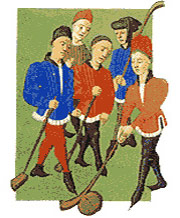
(Duchess of Burgundy, 1450)
In 1353 appears the first recorded reference to “CHOLE”, a popular cross country game being played in Northern France (where it was sometimes also called SOULE) and Belgium between the 13th and the 15th century. While chole players used wooden bended clubs and traditional leather filled balls, the game was more similar to hockey, as it was played with one common ball by two different teams, with the objective to achieve a specific target (a gate, a door or even a couple of rocks).
The two teams were playing one against another in the sense that, first, one team was shooting the ball in one direction (the chole) and after it was the task of the other team to countershoot the ball (the decholade) in the opposite direction. Each team had a “chole” made of a sequence of 3 consecutive strokes before the ball belonged to the opponents for their “dechole” that consists in one single stroke (aimed to shot the ball as far as possible from the goal and in a difficult area). The game was played in open fields usually using natural hazards as part of the difficulty to reach the objective.
1421 – A Scottish regiment aiding the French against the English at the Siege of Bauge is introduced to the game of chole. Hugh Kennedy, Robert Stewart and John Smale, three of the identified players, are credited with introducing the game in Scotland.
Another, simpler, version of Chole was “CROSSE” also being played in France.
In the 15th century, another popular game in England (mainly London and its suburbs) was called “PALL MALL” (pronounced pal-mal or pell-mell) or palle maille. The name comes from the pallamaglio, which literally means “ball-mallet”. The object was to strike a boxwood ball of about 1 foot (30cm) in circumference (about the same size as a modern croquet ball) with a heavy wooden mallet from one pre-determined place to another, sometimes as far as neighboring villages near London.
Pall mall was popular in Italy, France and Scotland, and spread to England in the 17th century. The name “pall mall” refers not only to the game, but also to the mallet used and the alley in which it was played. It is considered by some as the precusor to croquet.
A variant of Pall Mall became increasingly popular in the South of France was JEU DE MAIL. This one was played with straight wooden clubs that had a sort of hammer shape at one hand called “mail” (i.e. wooden mallet). The scope of the game was to shot a wooden ball (!) till a specific target, normally an arc, located at ½ miles or longer from the starting point with the minimum number of strokes. As in modern golf, this was one of the few ancient sports where each player was playing with his own individual ball for the whole game. See below picture for reference:
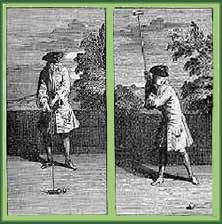
published 1891
The Jeu de Mail was very popular at its time. The book written by A. Robb (Historical Gossip about Golf and Golfers), offers a very detailed description of the game that resembles modern golf quite a lot with the exception that the target is never a hole but a designated mark on the ground. The clubs, hammered shaped, were designed to cope with bad lies as on one end they had a sort of flat shape to give the club with some loft in case of needs.
It is worth mentioning that this game was still played in some small villages of southern France untill last century.
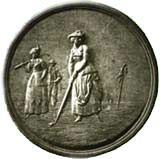
It is chronicled that two teams of four, equipped with wooden clubs, hit wooden balls over a ‘course’ measuring 2,5 miles. The targets were outside doors with the objective for each team to score a “goal” in the lowest number of strokes. The fact that this game was part of a “local celebration” is a sign that “kolf” should have been a popular game at that time.
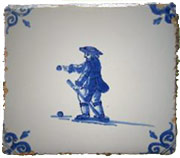
The game of Kolven appears in many Dutch paintings, pottery, tiles, suggesting its popularity at that time. Its popularity remains very strong even today as is not uncommon to see players in the Northern part of Holland. At origin it was an indoor game but it soon developed also as an outdoor sport being played on ice (on frozen channels, small lakes and rivers) or on kolf courts specifically confined for the game.
Some golf historians claim that the origin of golf as well as of the word “golf” itself originate from kolf. Van Hengels and J.A. Brongers, considered two of the most acknowledgeable Dutch golf historians, based their theory on the frequent trading exchanges between Holland and Scotland in medieval times and reinforced their theory claiming that there is “golf evidence” dating back to 1300 – in documents, paintings and sketches, even before the first record of golf in Scotland.
However, there is also proof of the opposite.
First of all, the dutch kolf is played with the objective to hit a specific post with the fewest possible strokes. The game could be played either in teams (one against another) or by single individuals but only with one common ball. Moreover, it was played in a confined area (outside or inside), indicating similarities with hockey rather than with golf. Futhermore, a book dating from 1795, the Statistical Account of Scotland, clearly described the game kolf as different from golf. This proves that, already in those years, Scottish people were very clear about the differences between golf and kolf. It is worth remembering that the word “golf” was first recorded in 1457, in an act of the Scottish Parliament, when the sport was banned because it interfered with military practices (such as archery…).
Recommended books:
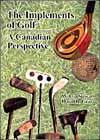 The Implements of Golf:
The Implements of Golf:
A Canadian Perspective (Mercury Series, History Division, Paper 49)
by W. Lyn Stewart, David R. Gray
More information:
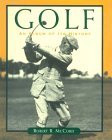 Golf : An Album of Its History
Golf : An Album of Its History
by Robert McCord
More information:
 Golf
Golf
by Dale Concannon
More information:
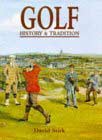 Golf History and Tradition
Golf History and Tradition
by David Stirk
Explores the possible origins of the sport staring with ancient Rome, and moving through all the significant events and developments of the sport. With biographies on significant golfers.
More information:
See also:
Asian origin of golf
Early Golf history in Europe and the whole Mediterranean basin
Chole, Mail, Kolven
Golf history from 1457 to 1847
Golf history from 1848 -1894
Golf history from 1895 – 1921
Golf history from 1922 – 1944
